Costumed in Gender, Haunted by Patriarchy
Part II of a series exploring what Halloween can teach us about the continued influence of patriarchal ideology in our world
My interest in exploring the gendered meanings of Halloween costumes did not begin as a scholarly endeavor. It began as I benignly walked the isles of costume shops as a father helping my young children find costumes in 2013. I began to recognize how narrow my 10-year-old daughter’s options were. The more I looked with a critical lens, the more frustrated I became.
Generally, “occupational” costumes—think police, doctors, firefighters, pilots, soldiers, athletes, etc.—were placed in the “boys” section. The models on the packages were also boys, just to make it perfectly clear who they were really meant for. And when I began to scrutinize the boys’ offerings, I realized that they too were limited. There were no ballerinas, flight attendants, butterflies, or cheerleaders for the boys. Some readers may scoff and roll their eyes at the last sentence, thinking to themselves, “of course not!” And yet those same eye-rollers will know perfectly well that there are, as a matter of fact, male ballerinas, male flight attendants, male butterflies, and male cheerleaders. There were in 2013. And there are, today.
Halloween costumes have and continue to offer us a window into another dimension of ourselves and society; a chance to gaze into the often hidden yet constantly present “upside down” of ourselves. By critically examining popular, mass marketed costumes we learn something about the persistent and pernicious power of a 5,000-year-old worldview that silently shapes our individual and social lives: patriarchy and its narrow, dehumanizing, sexist vision of not only female but also male humanity.
It may seem strange to learn about the “real world” through one of our society’s most whimsical and seemingly imaginative holidays. But invaluable insights into who we are and what we believe, as men and women, lie just beneath the witches’ hats, monstrous masks, and muscle-padded superhero body suits.
The Frightening Realities of Patriarchy
In The Creation of Patriarchy (1986), historian Gerda Lerner details patriarchy’s development over a period of about 2,500 years, from 3,100 BCE to its crystallization around 600 BCE. Lerner showed that women were among the first human beings ever enslaved with the aim of profiting from their unique capacity to generate new life; life that has and continues to be the source of power, be it economically as a source of labor or militarily as a source of soldiers.
Patriarchy’s unabashed purpose has been the establishment and defense of the prioritization and supremacy of males over women. Turning to the preeminent and influential thinker, Ancient Greek philosopher, Aristotle we learn something of the essence of the patriarchal thinking that continues to haunt us. In part XII of Politics (350 BCE). Aristotle, explained that males’ right and responsibility to rule over females was rooted in their biological nature.
“For although there may be exceptions to the order of nature, the male is by nature fitter for command than the female, just as the elder and full-grown is superior to the younger and more immature.”
While each has the potential for moral virtue, this virtue differs depending upon the nature of each. In part XIII he wrote:
“the temperance of a man and of a woman, or the courage and justice of a man and of a woman, are not, as Socrates maintained [in Plato’s Meno], the same; the courage of a man is shown in commanding, of a woman in obeying…. All classes must be deemed to have their special attributes; as the poet says of women, ‘Silence is a woman’s glory,’ but this is not equally the glory of man.”
Aristotle recapitulated and perpetuated patriarchy’s definition of manhood and womanhood, a fallacious definition rooted in a self-serving stereotype. Stereotypes erroneously assert that all members of a particular group necessarily possess a quality that is actually accidental or incidental to being a member of the group. To stereotype is to insist that a particular characteristic is essential to being a member of a group when that characteristic is in fact inessential to group membership. When I insist that the king is a member of the royal family, I am not stereotyping; I am accurately deducing the meaning of being a king. But I am stereotyping if I insist that all kings are, by their essence or “nature,” particularly brilliant or brave. I am also stereotyping when I claim that someone’s biological-reproductive sex determines their individual character—whether they are courageous or compassionate—and capabilities—whether or not they are athletic or good with children.
Groups and their members can be both negatively and positively stereotyped. Aristotle negatively stereotypes women as inherently less capable of leadership while positively stereotyping men as more capable of leadership. In a word, he essentializes men and women, insisting that being a male or female-bodied person biologically determines not only our reproductive capabilities but also our cultural-social roles in society.
Aristotle’s thinking resounded for centuries. In Summa Theologica, Middle Ages’ theologian, Thomas Aquinas wrote,
“Woman is naturally subject to man in this kind of subjection because by nature man possesses more discernment of the reason.”
Some five hundred-years later, during the “Age of Enlightenment,” the French free-thinker, Diderot, wrote,
“Because the male of the animal species has more courage and strength than the female, this term was transferred to things intellectual, and people said a manly mind, a manly (virile) style, a manly thought.”
Though ancient in origins and logically antiquated, this dehumanizing vision of women informs common sense practices and assumptions in the present. It is no small irony that the patriarchal worldview is often perpetuated by people who are ostensibly or consciously opposed to it.
Patriarchy’s Guide to Halloween
Patriarchy's continued influence in our culture is clearly seen when we critically examine the general differences between Halloween costumes marketed and available to boys and girls. A perusal of your local department store or the nearest corporate costume chain, like Spirit Halloween or Party City, reveals distinct conceptions of what it means to be a boy and girl.
Boys are invited to imagine themselves as doctors, firefighters, police officers, soldiers, action heroes, and an assortment of (scary) zombies, skeletons, dinosaurs, and clowns. Girls, by contrast, are invited to be princesses, fairies, angels and an assortment of “cute” insects (butterflies, bumblebees, ladybugs) or animals (kitties, unicorns, bunnies), and a far fewer assortment of action heroines.
The psychiatrist James Gilligan reminds us that manhood has and continues to be crucially linked to violence. Backed by tomes of evidence from human history, Gilligan writes, in Preventing Violence (2001):
“Masculinity, in the traditional, conventional stereotypical sex-role of patriarchy, is literally defined as involving the expectation, even the requirement, of violence, under many well specified conditions: in time of war; in response to personal insult; in response to extramarital sex on the part of a female in the family; while engaging in all-male combat sports; etc.”
Men have been defined and thus conditioned to be the violence objects of the powerful. By contrast, the powerful have defined women as objects of beauty, sex, and reproduction. Gilligan writes that patriarchal culture honors women, primarily, on the basis of their
“sexual chastity outside marriage, and fidelity (and fertility) within marriage. I am calling that female gender role the equivalent of being a 'sex-object' because it means that the woman is obliged to renounce her own sexual subjectivity; she is not permitted to have sexual wishes and activities of her own choosing, before, during, or (in some cultures) even after marriage, but must instead be her husband's sex-object.”
An example of these ancient ideas linger in contemporary culture presented itself in October 2022. An acquaintance on social media posted a lament about girls at his son’s high school walking up to boys at a high school dance to ask them for a kiss on the lips. Several people were aghast at the girls’ behavior and spoke with fondness of the “old days” when boys initiated such interactions.
In recent years the number of “occupation” and superhero costumes marketed to girls has increased, but they are still significantly less than those offered to boys. For Halloween 2023, Party City offered girls 17 choices in the Superhero category whereas boys had 40 choices. Spirit Halloween offered girls 16 options in “Occupation and military costumes” compared to 38 choices marketed to boys. Target also gives boys more than twice as many hero costume options as girls.
Even as modest gains are being made in liberating children of a patriarchal gender ideology masquerading as biology, a closer look at the details of ordinary costume selections reminds us of how remains unchanged. Costume names and designs undermine what might otherwise appear to be costume gender parity.
At Party City and Spirit Halloween, when boys are pirates they are “kings,” “rascals,” “looters,” or “rebels.” When girls are pirates, they are “precious,” “beauties,” “cuties,” and “sweethearts.” When boys are ninjas they are “warriors,” “avengers,” and “dragon slayers,” while the offering for girls may be something like “Sassy Samurai.” Girls can even be “sassy” space girls, but, unsurprisingly, no such “sassy” offerings are provided in the boys’ section. She can’t just be a devil, witch, or a cat, she has to be a “Devil Diva,” “Darling Witch,” or “Pretty Kitty.” Even if the girls’ devil costume is called “Fiery devil” the design of the costume, including footless tights and dress, makes it clear being cute remains a top priority.
Costumes geared toward boys represent characteristics, as evidenced in the names, and/or professions that elicit social respect and financial stability. Those marketed to girls highlight comparatively diminutive qualities and roles, as per the dominant culture, indicating that one is pleasant but not necessarily “powerful.” Given that our society rewards a kind of power associated with assertiveness, leadership, even aggressive dominance, the implications of such symbolic associations are clear.
These symbolic stereotypes reinforce the idea that one group is more valuable or important than the other. Add to this that many continue to find it easier to imagine men into positions of power and authority than women and it becomes all too clear that Halloween costumes perpetuate patriarchal visions of girls and women; visions where girls play minor, supportive, or simply unserious roles.
The naming and designs of superhero and law enforcement costumes also tell us something about the continued stereotyping of girls in our society. Batgirl and American Dream, for example, come with skirts or “tutus” that suggest they are more ready for a dance recital than doing physical combat against ruthless foes.
This difference further suggests the continued expectation that girls obey patriarchy’s dictate that “beauty” (and “sexual attractiveness,” in adulthood) and agreeability, communicated through “cuteness,” are cornerstone of female identity and worth. As the renowned German philosopher Immanuel Kant explained, in Observations on Feeling of Beautiful and Sublime (1764), women are known most defined “by the mark of the beautiful.” They are by nature “more delicate and gentler.” Whereas men had a “deep” or “sublime” understanding of the world, women’s understanding was connected to beauty. “Women have a strong inborn feeling for all that is beautiful, elegant, and decorates.” Whereas men are naturally inclined to reason, women are naturally inclined to the senses. Cementing the patriarchal conception of feminine essence as attractiveness in appearance, Kant wrote
“A woman is embarrassed little that she does not possess certain high insights, that she is timid, and not fit for serious employments, and so forth; she is beautiful and captivates, and that is enough.”
That mass marketed costumes reflect and reinforce patriarchy's appearance-based definition of womanhood is further illustrated by the most common words used to describe junior girls’ costume names: “sweet,” beautiful,” “honey,” “heartthrob,” “sweetie,” “sassy,” and the most common of all, “cutie.”
The presentation of boys’ selfhood is not without negative implications. Feminist theorists including Jackson Katz and bell hooks argue that gender stereotypes not only dehumanize girls, excessively emphasizing their status as “beauty objects,” they also promote the dehumanizing vision of male-selfhood as fundamentally centered around the capacity for force and violence.
Halloween costumes for boys (and men) overwhelmingly identify maleness with a particular kind of power, namely power to provoke fear or enact violent force, through guns, strength and/or superpowers. This is not the only vision of power. As the authors of Packaging Boyhood (2009) write,
“Power can be about physical strength and dominance, but it can also be the power to change someone’s point of view, persuade evil to be good, to challenge others to do good things.”
Beyond the toddler age, boys’ costumes overwhelmingly communicate menace compared to girls’ costumes. As the authors of Packaging Boyhood write,
“For the youngest boys there’s the occasional Pooh Bear or SpongeBob, even a cute puppy or lion, but they are buried in an avalanche of ninjas, special Delta force soldiers, and Transformers.”
A few years back, I remember watching a father discourage his four or five-year-old son from choosing a Thomas the Tank Engine Train costume. The dad urged his son to choose something more menacing, more “cool.”
Behind the Mask of Patriarchal Gender
Many see no problem in the mass marketing of polarized costume choices for boys and girls. It just seems natural for little girls to want to be princesses and little boys to want to be murderous zombies or heroic soldiers. But feminist theorists argue that such thinking is the result of patriarchal bias and cultural indoctrination rather than biological reality.
While the words “gender” and biological “sex” are used interchangeably, feminist thinkers of the 20th century recognized that much of what was attributed to biology was the result of (hu)man-made culture and society, not nature. In an ideological sleight of hand, patriarchal culture anchored its social norms and prescriptions for men and women in the reproductive-biological categories of maleness and femaleness. But these social norms pertaining to who wears makeup and high heels, what our favorite colors are and who should lead weren’t based on biological sex, which has to do with chromosomes (XX and XY) and primary sexual characteristics (ovaries and testes). Reproductive sex pertains to the classification of animals to make sense of reproduction. Gender was and still is something quite different.
Gender does not describe biological realities; it proscribes social norms and roles based on patriarchal assumptions of what it means to be a reproductive-biological male or female. There is no biological basis for dictating that those with ovaries are best suited for wearing dresses, makeup, and high heels; or that those with XX chromosomes are “naturally suited” for domestic duties such as cooking and cleaning while those with XY chromosomes and testes are better suited for operating power tools and taking out the garbage.
The conflation of gender and biological sex is widespread. Consider conservative social commentator, Candace Owens’ condemnation of British pop star Harry Styles' choice of attire for a 2020 Vogue Magazine photo shoot. For Owens, Styles’ wearing of a dress with ruffles was part of a larger pattern of “feminizing” men, which she described as “an outright attack.” She concluded her social media post pleading that we “Bring back manly men.”
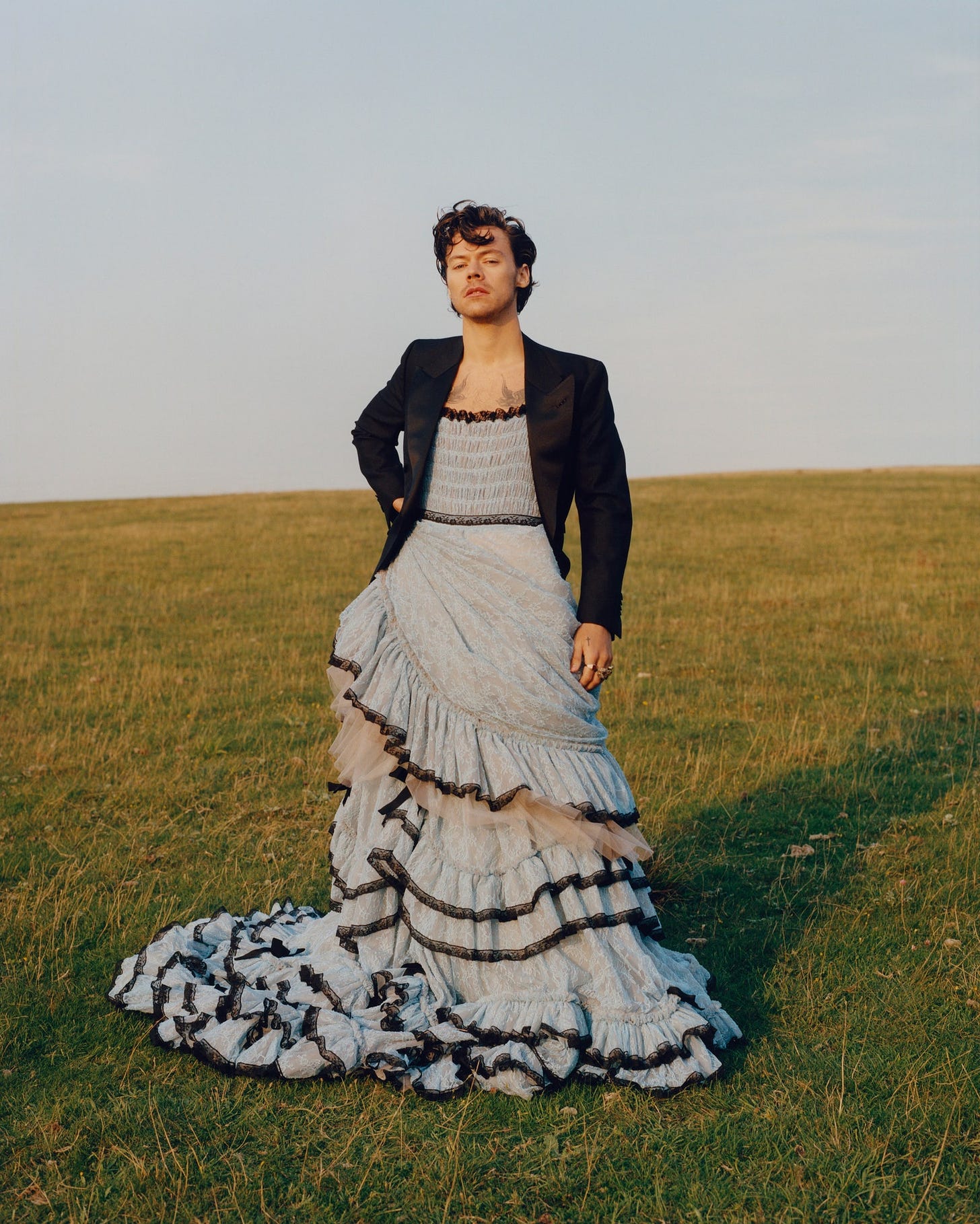
Gender is an evaluative belief system that avoids scrutiny by being masked as “the way things are.” Under the guise of merely describing what is an empirical fact, patriarchal gender actually dictates what should or should not be the case for us. Social roles, activities, behaviors, and characteristics—even colors!—are assigned to males and females based on what patriarchal gender has deemed appropriate for them. Yet these prescriptions are clearly non-biological since prescribing a person to be something they already are, would be redundant, like insisting that water be wet, snow be cold, and fire be hot. If being a man or woman was strictly about biology we would have very little to be instructed in. To say “Bring back manly men” would be the same as saying “Bring back cold ice” or “Bring back hot fire.”
I am not arguing that we should abandon value judgments about what it means to lead happy, ethical lives. Value judgments and ethical prescriptions are essential for living a meaningful life. Contemplating our personal identity—the nature and/or trajectory of the “self”—is also a fundamental part of the human experience. Yet the dictates of patriarchal gender ideology are not made in open, rational dialogue; they are communicated and enforced through manipulative shaming and uncritical adherence to the culturally dominant patterns of thought, belief, and practice. We are inculcated into patriarchal gender’s narrow and often deforming standardized self as children. By the time many of us come of age we have already internalized these standards as though they were the expression of our chromosomes, further hiding their social-cultural origins.
Gender cloaks its prescriptive beliefs in the garb of biological determinism—an assertion that something must be because it is inherent and thus beyond the power of human choice to change. Patriarchy’s gender ideology attempts to dictate to others not only what to do or how to behave, but who to be. As such it constrains and undermines male and female wholeness and dignity with its exploitative vision of polarized humanity. It is a belief system that invasively dictates our personal identities, further clouding the already difficult human pursuit of living lives of authenticity. In this sense, patriarchy’s gender ideology infringes, through anonymous authority, upon the autonomy of male and female-bodied persons to determine, for themselves, not only who they presently are but also who they wish to become.
The pernicious effect of patriarchal gender is never more openly on display than on Halloween night when we see how narrow our self-conceptions are framed; when we see how few of us are invited or dare to imagine ourselves into some other sense of self, some other possibility.
Poltergeists, Police, and Gender Polarization
Mass produced children’s Halloween costumes reinforce polarized definitions of maleness and femaleness. Polarization is an important aspect of patriarchal gender whereby the differences between men and women are irrationally exaggerated at the expense of recognizing the overwhelming convergent characteristics. Polarization is more than recognizing differences between males and females; it’s the insistence that they are radically different, even opposite: one group from Venus and the other from Mars.
The boys are cast as those acting forcefully, be it as the hero or the villain, the cop or the robber. The girls are cast the role of playful, whimsical, and cute. Even when her costume is occupational, heroic, or ghostly, the names of the costumes and the models exemplifying the costume remind girls that being “adorable” or “beautiful”—pleasing—is the highest priority.

More occupational costumes are available for girls, today, at stores compared to ten years ago. But most of these costumes make cuteness the priority over inviting girls to seriously envision themselves into roles such as police officers. Thus we find costumes like Spirit Halloween’s “Cute Cop,” “Officer Cutie,” and “Sassy Sergeant.” Each costume comes equipped with a police badge, hat and…a skirt, the perfect attire for a female officer in the line of duty. I’m sure that I will surprise exactly no one when I write that there are no such costumes marketed to boys. Such language would be deemed too patronizing or trivial to be directed at the definitionally self-important boys. The language of cuteness suggests a degree of passivity reminiscent of Aristotle that runs counter to the most basic definitions of those symbolically associated with seriousness and power.
As much as we think of Halloween as a day for children and adults to “dress up” and set our imaginations loose, most end up Trick-or-Treating with patriarchy, choosing costumes that reinforce ancient stereotypes about the essence of maleness and femaleness.
If you missed part I, click the link below and check it out.
Read part III at the blink below.
If you enjoyed this post please share it with others and like it by clicking the heart icon. Be sure to subscribe if you haven’t already.
Invite Dr. Nall to Speak
Dr. Nall delivers energetic live presentations and engaging workshops on the subjects featured in Humanities in Revolt. Those interested in booking a workshop or talk can get in touch through Facebook or by leaving a comment.




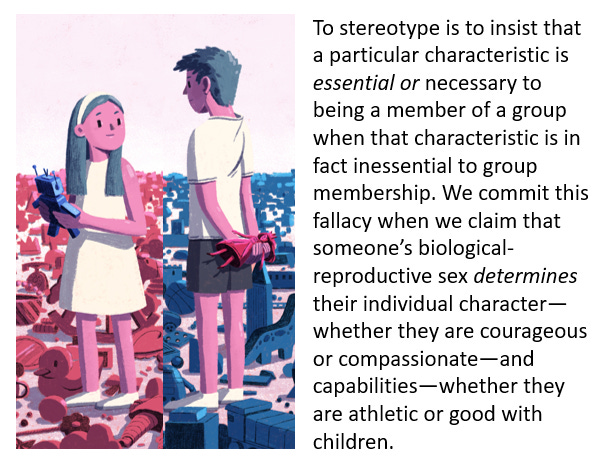

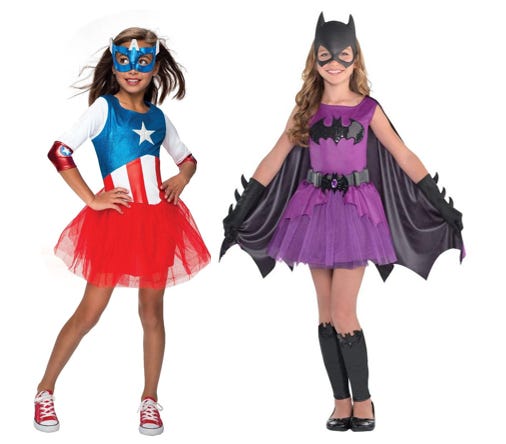
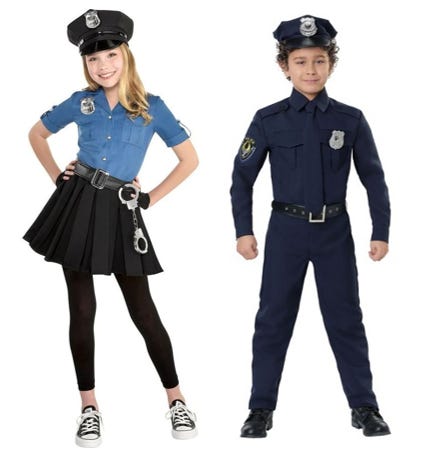
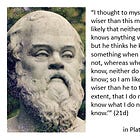
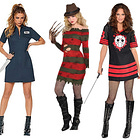

Until the Spanish brand Zara arrived, the selection in UK men’s clothing stores was dire.
Yes. There are several contexts to masculine v feminine.
To name a few:
Psychologically Archetypal
Behavioral - biology based
Behavioral - socially conditioned
Biological Gender
Sexual Orientation
You raise only the Halloween “socially conditioned” one in your article. Which imho is a very narrow perspective on the topic.
You also mention “feminist philosophy”. As if there was any sort of consensus in that arena.
While I appreciate your anecdotal “walk through the costume shop” observations, I believe the entire “gender studies” space could use a more useful framing, taxonomy, and definitional “level setting” to engage any productive dialogue.